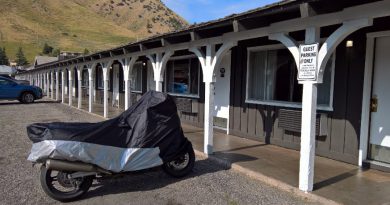
Motorcycle Security for Sport Touring Riders
It’s late, do you know where your motorcycle is? Probably where you left it. But sometimes, life can surprise us. And finding your motorcycle missing in the morning, particularly on a touring ride, is the worst kind of surprise. Motorcycle theft is a real problem across the United States as well as in Canada and Mexico. Once you know how thieves are making off with motorcycles, you can take steps to avoid becoming a victim yourself. And that is our goal today.
Every stolen motorcycle affects someone’s pocketbook and inevitably causes heart ache at the most inopportune time. Motorcycles can disappear on a ride as easily as they do at home. Taking steps to keep from falling victim to theft is time well spent.

Keeping a motorcycle safe at home is easier than on a tour. The same security options at home are simply not available on a tour. For example, a locked garage. Or in the absence of a garage, a handy post or other immovable object to chain the bike to. Home security cameras can help keep an eye on things at all hours. But cameras are not always available or well positioned on a tour.
Touring riders by necessity are forced to strike a balance between portable anti-theft devices and touring quality and convenience. Here are practical security tips for sport touring riders.
Motorcycles Are Stolen as Often as Cars
It may be reassuring to know that as a group, motorcycles are no more at risk of theft than any other motor vehicle. The total number of registered motorcycles in the United States is a low 3 percent of total vehicle registrations, yet both motorcycles and all other motor vehicles are stolen at virtually the same 1% per year rate.

Thieves operate a thriving marketplace in stolen motorcycles and motorcycle parts. According to crime data, thieves target all motorcycle makes and models equally. Data show the percentage of stolen motorcycles compared with registrations is similar across all brands. Police advise riders that motorcycle thieves are opportunistic and inclined to take the easiest, least secure, targets first rather than seeking out specific makes and models,
Despite a 3% decrease from 2020 to 2021, motorcycle thefts are still up 26% overall from 2019. Of the nearly 1 million total vehicles stolen last year, 51,291 of them were motorcycles. August was the hottest month with almost 6,000 cycles swiped.
National Insurance Crime Bureau
How to Steal a Motorcycle
The most common method to nab a motorcycle is to simply pick it up, put it in a van or truck, and drive off. No need to know how to ride and no time wasted fiddling with the ignition. Advances like passive keyless entry systems make a ride-off virtually impossible. Without a matching key fob, the engine control computer remains disabled, and no amount of hot-wiring ingenuity will get past that.
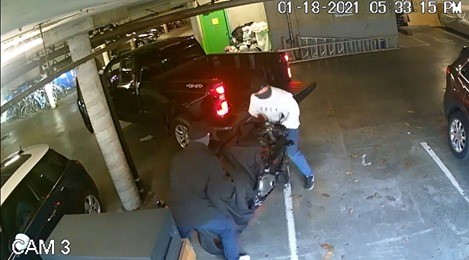
Chains aren’t a sure thing either. Most of the time a thief can cut through even the best locking chain in less than 5 minutes. A chain slows them down, and it may discourage them, but it won’t stop them if the bike is left in an out of the way location.
Once stolen, most bikes are disassembled and sold off for parts. In today’s data-everywhere world with highly accurate and timely registration and VIN numbers readily available, it has become much harder to sell a hot bike. The tendency to part out rather than sell a stolen bike may help explain why only 44% are recovered (per NICB data for 2018) compared with 59% of stolen cars.
A Practical Approach to Reduce Theft
Touring riders can take practical steps to keep their motorcycle out of the hands of a thief. Since the same strong security tactics used at home are either constrained or off the table all together on a ride, two measures are recommended to significantly reduce the risk of theft.
The first is to consistently use the locks that come standard on every motorcycle. No exceptions. And the second is to strengthen those with a few extra steps that are easy to take along on a tour. Using this two-part approach gives riders flexibility to apply appropriate tactics for any situation.
It goes without saying that no anti-theft strategy can guarantee total protection. But these steps are sure to make your motorcycle a less attractive target. Real-world experience shows thieves pass over bikes with good security in favor of those with little or none. Put these steps to work every time you park.
Security for Daytime Stops
The first step to secure your motorcycle is obvious and hopefully routine – simply lock the ignition. Perhaps less routine, but still helpful, is to lock the steering head. Steering head locks may have a reputation as easy to defeat, but they are still a deterrent and worth the minimal extra effort to use.
Once locked, remember to remove the key or key fob. Don’t leave extra keys on the bike, particularly in an obvious location such as a tank bag or tail bag. These simple steps form the foundation of a solid security strategy.
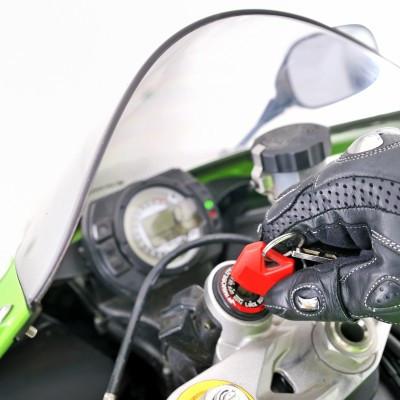
There are a few more simple things to consider every time you park. Even before locking the motorcycle take a look at the surrounding area. Be sure you are comfortable that the bike is in a safe spot. Try to park where you can keep an eye on your bike from wherever you go, or at least in a spot where store keepers and hotel clerks can keep an eye on it and better still where plenty of pedestrians are passing by. When parking in a hotel garage, look for a spot with security cameras. The more visible the better. And of course park in a designated space – you don’t want to lose your bike to a tow truck.
Two more important things every rider should do before leaving home. First, store an image of your title and registration on your phone or on internet accessible cloud storage such as Microsoft OneDrive or Apple iCloud. Don’t leave either document on the motorcycle. The police can work from images should you need it for a traffic stop. Same thing for insurance cards, keep an image on your phone or in the cloud. And it helps to have pictures of the bike itself available as well.
These basic steps are all you reasonably need for most stops on a touring day, whether at lunch or while off exploring a nearby sight.
Locks & Alarms for Overnight Security
When the riding day ends, and the time comes to park the bike for the night, good security is more important than ever. Motorcycles are stolen at all hours, but most thefts occur at night under cover of darkness.
Start by using all the security that comes with your bike, just as you would if you were parking for lunch. But be extra careful about choosing a spot. Look for good overnight lighting. The safest hotel parking spots are those that can be seen from the front desk. If that’s not possible then find a busy location such as near a side door where people might pass by at any time. Set the locks – ignition and steering head. Remove the keys.
Unlike short stops during the day, additional security beyond ignition locks are recommended for overnight parking. Because thieves don’t expect riders to return to their motorcycles until morning, they have plenty of time to break locks, lift bikes onto trucks, or simply roll them away. It’s essential to make any of those options as difficult as possible. Here are three recommendations that will frustrate a thief.
Don’t Let it Roll
You can easily prevent rollaway theft by using a disc lock. These locks are small, easy to bring along on a tour, and highly effective. The lock clamps to a front rotor (or less commonly the rear) using a pin through a disc vent or cut-away.
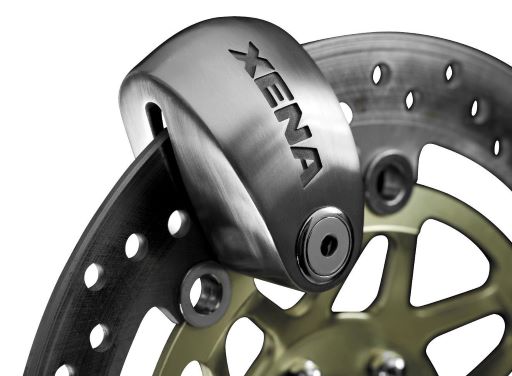
Once on, the wheel won’t turn past the brake caliper preventing a thief from simply walking the bike away. The best disc locks are made from high-strength steel, use 14mm locking pins, and have freeze-proof mechanisms. Some disc locks also come with a built-in motion-activated alarm. Because a disc lock weighs less than 2 pounds and measures approximately 8x7x2 inches they’re easy to pack in a tail bag. A good disc lock is likely to cost about $125.
Make Some Noise
Fundamentally, motorcycle alarms come in three designs; either integrated with the motorcycle itself, an aftermarket add-on, or as mentioned above built into a disc lock. The choice largely comes down to cost and convenience. All three can be effective.
Alarms are typically triggered when they detect motion. Better alarms have adjustable motion sensitivity and emit a siren of at least 110db. Unlike a disc-lock alarm, built-in and add-on alarms often come with a remote control to activate and deactivate the alarm. High end alarms can automatically deactivate when the owner approaches.
A disc lock alarm is the easiest solution. But disc lock alarms are tricky to operate and frequently activate when locking or unlocking from the bike. Setting the right motion sensitivity level can be challenging. In spite of all this, a disc lock alarm is certainly better than nothing at all.
Built-in and aftermarket alarm systems on the other hand offer more sophisticated options. The motion sensitivity can be adjusted, a remote control enables arming and disarming from a distance, and because the alarm is mounted on the bike it is convenient to use anytime during the riding day. Some of the more advanced alarm systems can even send an alert to the rider’s mobile device when motion is detected. A good quality aftermarket alarm can cost between $200 and $300 dollars.
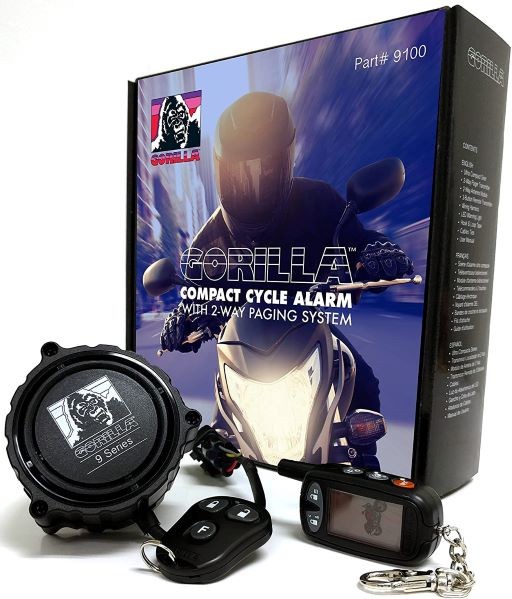
By now you may be asking “what about LoJack?” LoJack systems are designed to send a notification to the police and a monitoring service in the event the motorcycle is moved. The system uses GPS tracking and has proven effective in helping police recover stolen bikes. However, it’s important to recognize that LoJack systems won’t prevent theft in the first place. LoJack stopped selling products for motorcycles and later in June 2021 did the same for cars. Similar GPS-based tracking products are available; all require purchase of a tracking device and an on-going subscription fee for the service itself.
Cover it Up
Locks and alarms help keep your motorcycle safe overnight, but for an extra measure of assurance we recommend using a bike cover. Covering the bike makes it much harder for thieves to spot potential targets. Instead, they are likely to roll right past your bike in favor of a plainly visible opportunity. In addition, covers keep curious hands off while at the same time protecting the bike from bad weather.
Even with a cover, it’s still a good idea to remove items like GPS, tank bags, and tail bags. Lock them in the side cases if possible.
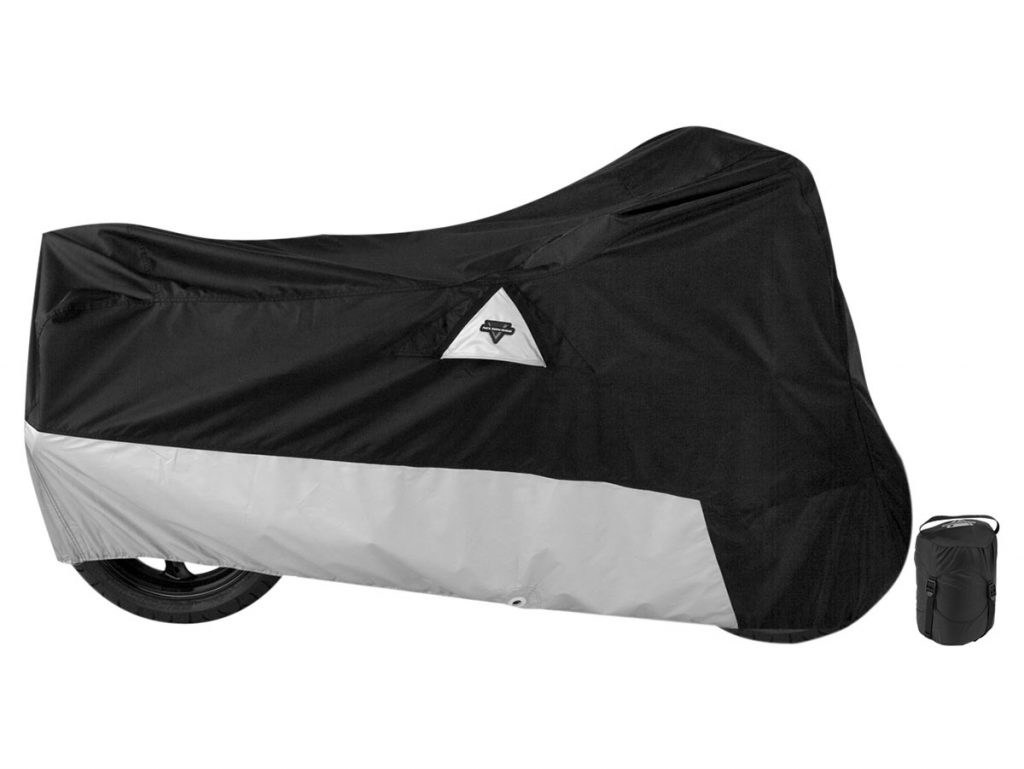
A good quality motorcycle cover is completely waterproof, covers the entire bike, is made from durable material, has gromets to tie it down, and stows away in a compact compression bag. Covers from Nelson-Rigg are a good example of a high quality cover at a fair price. Learn more about motorcycle covers in How to Pick the Right Motorcycle Cover.
What To Expect If Your Bike Is Stolen
Consistently applying good security practices will help assure your motorcycle stays safe on a touring ride. But even the best defense is not foolproof. Sometimes the bad guys win. When that happens emotions run hot. Knowing what to expect and having a plan in mind takes some of the stress out of the situation. Don’t waste time – the sooner one acts the better the chances of recovery.
Confirm your bike really was stolen – Look around the area. Perhaps someone had a reason to move it. Or maybe the bike was towed because it was in a no parking zone? Check with the hotel front desk or security.
Call the Police – Once you confirm the bike was stolen, it’s time to call the police. Be ready to describe the motorcycle, and provide pictures if you can, along with important details like license plate number and registration information including the VIN. The responding officer will give you a copy of the police report containing the Police Report Number. Your insurance company will want a copy of the police report.
Scout the area – Double-up with a riding buddy or call an Uber to drive you around the neighborhood. A joy rider may have left the bike a few blocks away. Definitely a longshot but going the extra mile will keep you from second guessing yourself later.
Call your insurance company – Similar to the police, be ready to describe the circumstances and provide the police report. Depending on your policy the insurance company may cover a rental car. Beyond that, there’s not much they can do to help while you are on the road.
Be vigilant – While stolen motorcycles often go straight to the chop shop, sometimes they wind up on sites like Craigslist for a quick sale. It doesn’t hurt to check online listings for a few weeks.
Smart and Practical Security Precautions
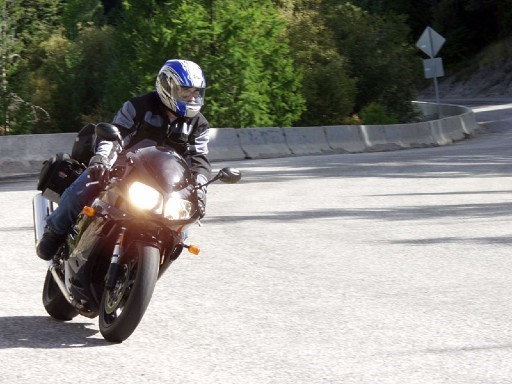
There’s no getting around the emotional toll and inconvenience of having your motorcycle stolen. It’s bad enough to lose a bike near home, but orders of magnitude worse when it happens on a ride.
Acting on these recommendations will go a long way toward preventing your motorcycle from being stolen. Ultimately, keeping your motorcycle safe on sport touring rides comes down to situational awareness and consistently following good security practices.
[placeholder text]
Your response is used by American Sport Touring only, we do not store or sell your information.
Please read our Privacy Policy.

by John DeVitis, Editor and Publisher
John DeVitis, Editor & Publisher of American Sport Touring, has spent years riding and writing with a focus on long-distance, performance-oriented motorcycling. His time on the road has revealed little-known routes across the United States and Canada, along with practical insights into the bikes, gear, and techniques that matter to sport touring riders. He draws on this experience, together with a background in digital publishing, to guide the editorial principles and clear vision behind American Sport Touring, delivering content riders can trust.
Resources
| Site | Link |
|---|---|
| National Insurance Crime Bureau motorcycle theft data | https://www.nicb.org/news/news-releases/nicb-report-motorcycle-thefts-fall-again |
| Insurance Information Institute; Facts & Statistics | https://www.iii.org/fact-statistic/facts-statistics-auto-theft |

